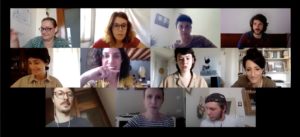The artistic residences were born to contrast an art made by few and for a few and with the aim to universalize the possibilities of making art so that it could become accessible even to those who, under normal conditions, would not have had the means, the tools and the time needed to create. This period that forces us to distance is making a serious blow especially to cultural circles: it is essential to rethink the ways of artistic use and transform (even if we hope only transiently) the residences, because it is unthinkable in a democratic perspective to give up experiences of comparison of this type and which above all give space, time and visibility to artists in training.
Despite the restrictions imposed by the spread of Covid-19, an alternative response to continue making artistic residences, carrying on a dialogue with many voices thus avoiding the isolation of ideas, and at the same time guaranteeing support for artists in the form of fees, it was given with the start of the Dimore – Artist Residence online project – initiative of the Youth Project Office of the Municipality of Padua.
The Dimore residence, just as the name evokes, refers simultaneously to the terms of staying, living – meaning also connected with the word residence – but also with the words of delaying, lingering; and it is on this ambivalence that the project takes inspiration. Through Dimore, the curators Stefania Schiavon, Caterina Benvegnù and Elena Squizzato have created a residence carried out, for the reasons already previously exposed, in virtual mode, but the interesting feature is that it is no longer the work of art in itself, the finished product that is placed at the center of attention, but the research and study process.
The website is the device to account for these processes, and therefore in Dimore you will never see works completed or exhibited in some museum, but the notes and suggestions resulting from the discussions and exchanges that take place every 15 days via the Zoom platform between tutors and artists, converting the characteristics of traditional residences into an innovative and experimental online form.
The residence designed for artists under 35 and active from 11 May until mid-July, has 4 thematic sections: Identity, Relationship, Imaginary and Metamorphosis, each one conducted respectively by tutors Elena Mazzi, Pietro Gaglianò, Babilonia Teatri and Emanuele Coccia, and sees the involvement of the artists: Daniele Costa (1992), Nicolò Masiero Sgrinzatto ((1992), Alessio Mazzaro (1985), Eleonora Reffo (1997), Gianna Rubini (1993) and Annalisa Zegna (1990).
The Dimore website is progressively updated and proposes the ideas and inspiring contents of the artists; at the moment the sections relating to Identity and the Relationship can be visited. Each area is held together by a conceptual fil rouge which, albeit through different ways and the use of different techniques and languages (such as photography, mixed media, videos or textuality), leads to questioning in a unified manner on questions posed by tutors.
As far as Identity is concerned, an idea of liquid identity emerged from the published notes which finds renewed meaning thanks to the encounter with diversity, the opposites, which thanks to their dialogue open up new ways of being.
While for the Relationship section, the artists put a meditation on themselves, their places and customs at the center, which inevitably also involves a gaze that spans elsewhere, in a redefinition of encounters with memories, customs, knowledge that too often for granted. Consequently, self-care becomes fundamental. A care that acquires meaning in an encounter with the other that takes place through a cognitive act which, while going outwards, leads to greater self-knowledge.
The Dimore residence has made social distancing, a particularly uncomfortable imposition as regards art and culture, one of the main and innovative factors of a new form of residence that is built around research, sharing and confrontation in a dynamic that it excludes the ephemeral display of the product in favor of a constantly evolving process, and a space in which to recognize research and the process as a fundamental part of the work of an artist who finds alternative possibilities in this new dimension.
Silvia Cegalin
Info:
 Elena Mazzi and the artists in residence during the online works session dedicated to the theme of Identity
Elena Mazzi and the artists in residence during the online works session dedicated to the theme of Identity
 Pietro Gaglianò and the artists during the online session on the theme of the relationship
Pietro Gaglianò and the artists during the online session on the theme of the relationship
 Gianna Rubini, digital photography from the Webcam.20 series, personal archive
Gianna Rubini, digital photography from the Webcam.20 series, personal archive
 Annalisa Zegna: Astrida Neimanis, “Hydrofeminism: Or, On Becoming a Body of Water” in Undutiful Daughters: Mobilizing Future Concepts, Bodies and Subjectivitiesin Feminist Thought and Practice, eds. Henriette Gunkel, Chrysanthi Nigianni and Fanny Söderbäck, Palgrave Macmillan, 2012.
Annalisa Zegna: Astrida Neimanis, “Hydrofeminism: Or, On Becoming a Body of Water” in Undutiful Daughters: Mobilizing Future Concepts, Bodies and Subjectivitiesin Feminist Thought and Practice, eds. Henriette Gunkel, Chrysanthi Nigianni and Fanny Söderbäck, Palgrave Macmillan, 2012.

is a contemporary art magazine since 1980






NO COMMENT